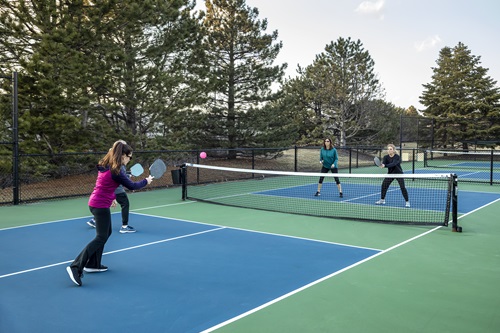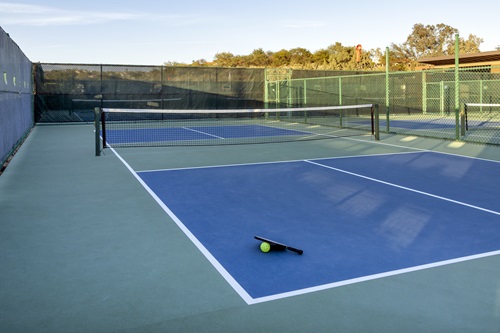
Photo © Unai Huizi | Dreamstime.com
Not enough courts to host all the players who want to participate. While it’s admittedly a better problem to have than its opposite (too few players involved, leading to too many venues standing empty, as with racquetball), pickleball is, at this point, growing so quickly that facilities can’t keep up.
That’s the word from the Sports & Fitness Industry Association’s (SFIA) most recently released research document, 2024 State of Pickleball: Participation and Infrastructure Report. The SFIA partnered with pickleball resource Pickleheads on the report.
Some of the top talking points from the report:
The Numbers. Seriously, the Numbers: For the third year in a row, pickleball is the fastest- growing sport in America, showing a leap of 51.8 percent from 2022 to 2023, and 223.5 (!) percent in three years, with every single age group seeing increased participation.
It’s Not Just an Older Demographic Any Longer: While initially, pickleball was associated with an over-50 age participation, the age group with the most participants, 2.3 million people, is actually the 25–34 age range. The sport added over 1 million children under the age of 18 from 2022 to 2023. The significant increase in youth participation also suggests a promising future for the sport as young players grow and continue to engage with pickleball.

Pickleball is Growing Nationwide, Not Just in Retiree-Heavy Areas: Every region in the United States in 2023 saw increased pickleball participation, with the South Atlantic region leading the way with 2.8 million pickleball players, a 50 percent increase compared to 2022.
Facilities Can’t Keep Up with the Demand: The SFIA notes, “The remarkable growth trend we are seeing underscores the need to apply facility data alongside detailed participation data to ensure the industry is doing what it can to keep up with the unprecedented demand of the sport.”
The number of dedicated pickleball facilities grew 55 percent year-over-year, nearly three times the growth rate of temporary facilities, which grew 14 percent. There is no question that as the pickleball industry matures, players are demanding dedicated facilities for the best playing experience. Dedicated courts have permanent lines and permanent nets, and are not shared with any other sport.
However, the majority of pickleball facilities in the U.S. are temporary (64 percent), requiring court equipment and setup in advance to play. Temporary courts (none of which are considered ideal solutions) are defined in the following way:
- Bring-your-own net: The facility requires the player to furnish and set up their own net.
- Portable: The facility provides players with portable nets on-site, often outfitted with wheels.
- Tennis nets: Pickleball can be played over an existing tennis net, which is 2” higher than a standard pickleball net, and generally unsuitable for competitive play.
Some Regions Are Investing in Pickleball More Readily: While every region in the U.S. added pickleball courts in 2024, the Mountain, West North Central, and the East South-Central regions all declined in their dedicated courts per 1,000 participants metric, as new courts added were not enough to offset the drastic growth in pickleball participation in these regions.
The 2024 report revealed that many of America’s largest metropolitan cities are catching up with last year’s laggards of New York, Los Angeles, and Chicago, as they all have doubled their dedicated courts per 10,000 people. There is still a long way to go as these three major markets are on average 92% below national averages for dedicated court density.

“Now in our second year of this report, we can see the pickleball industry has responded to the court shortage challenge by adding infrastructure, with dedicated pickleball facilities growing 55 percent year-over-year,” states Brandon Mackie, Co-founder and COO, Pickleheads. “Still, there remains a long road of investment ahead with $855 million needed to construct courts over the next 5-7 years.”
Six Trends Not Included in the SFIA Report (But Worth Noting): Over the past several years, the explosive growth of pickleball has lent itself to some new business models. Rec programs are implementing more pickleball league play and clubs are adding courts but the trend of repurposing vacant department stores and empty big-box stores has come to be known as “picklemalls.”
MarketWatch has been keeping an eye on the trend, calling it the savior of America’s malls. In fact, everything a pickleball club could want (a big space with high ceilings, lighting, HVAC, restrooms, accessibility, parking and more) can be found in vacant spots found in malls and strip retail centers. The new clubs bring business back to malls, particularly to businesses that cater to that public, with sports equipment, athletic shoes and other apparel – not to mention food courts, where players go to socialize after a game.
Just Adding Lines to Existing Tennis Courts Won’t Solve the Problem of Not Enough Pickleball Courts: In fact, it creates more problems. This issue was addressed by the United States Tennis Association early in 2023. The ideal solution to the demand for pickleball facilities is the construction of separate playing spaces, followed by second choice, the conversion of non-traditional spaces (parking lots, rec centers, etc.) for pickleball play. The last choice, and the least recommended, is to have tennis and pickleball players share spaces – something that has been seen as a recipe for trouble, since demand for playing time invariably causes conflict among players.
Building New Pickleball Courts Should be Done Mindfully: Attention should be paid to parking, rest rooms, lighting and access of facilities. Unfortunately, in the rush to add courts to satisfy demand, less attention may be paid to the location and amenities of facilities.
If Pickleball Courts Aren’t Built, Players May Try to Mark Their Own – Badly: In 2022, headlines were made when a pickleball player in Colorado used a permanent marker to make pickleball lines on a hardwood floor. He was accused of causing $9,344 worth of damage, which is what the parks department said it would cost to refinish the gym floor.
The man was far from the first to try this, nor, unfortunately, will he be the last. Surface manufacturers, flooring installers and facility owners have long complained about people using everything from markers to chalk to paint to tape in order to mark playing lines on indoor and outdoor sport spaces – which has led to problems later on. (Tape, for example, can ruin the finish on wood flooring and pull up the acrylic coating on outdoor flooring.) Recommendations are made to facility owners to take an audit of space uses and demands each year, with an eye to having lines professionally marked, or to building separate playing spaces.
USA Pickleball is Working with Manufacturers to Quiet the Sport: USA Pickleball has noted that products are being developed to make pickleball a good neighbor to those who have said they were bothered by the noise the game creates.

The Tournament Numbers Are Growing: USA Pickleball, the national governing body for the sport, in its most recent Annual Growth Report, noted a number of increases in tournaments. The organization sanctioned 195 tournaments in 2023 including a National Championships and National Indoor Championships. The National Pickleball League became USA Pickleball’s first sanctioned league in 2023, with 6 events at Chicken N Pickle locations across the country and a Championship held in Arizona in October of 2023.
The 2023 Biofreeze USA Pickleball National Championships powered by Invited and the PPA Tour were held at Brookhaven Country Club in Farmers Branch, Texas. The event drew nearly 3,500 registered players and 50,000 attendees, with the peak day welcoming over 9,500 fans – surpassing last year’s peak attendance at the 2022 Nationals by 4,000.
The 2nd annual USA Pickleball Diamond Amateur Championship was held at the world-class Pictona pickleball complex in Holly Hills, Florida. This championship saw 1,082 players compete in more than 2,945 matches during the week. Players took home more than 675 medals, with over 250 being gold medals that earned them a Golden Ticket and pre-registration to the 2024 Biofreeze USA Pickleball National Championships.
And that doesn’t include other events such as the Minto USA Open of Pickleball Powered by Margaritaville in Naples, Florida that in 2024 drew enthusiasts from all 50 states and 31 countries, from Armenia to Zimbabwe. In fact, over 3,250 players competed, while more than 50,000 fans celebrated the spirit of pickleball. Then there was the 2024 Beer City Open in Grand Rapids that was named one of SDM’s Champions of Economic Impact in Sports Tourism, making $2.4 million, consuming 1,374 room nights and drawing more than 7,000 spectators.
Those who want to purchase the SFIA/Pickleheads 2024 State of Pickleball: Participation and Infrastructure Report can use this link.

